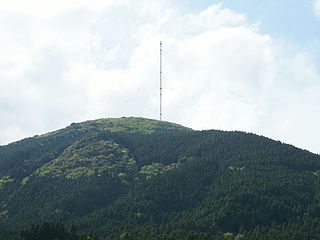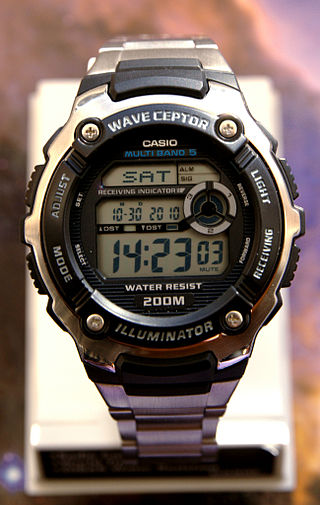Low frequency (LF) is the ITU designation for radio frequencies (RF) in the range of 30–300 kHz. Since its wavelengths range from 10–1 km, respectively, it is also known as the kilometre band or kilometre wave.

A radio clock or radio-controlled clock (RCC), and often colloquially referred to as an "atomic clock", is a type of quartz clock or watch that is automatically synchronized to a time code transmitted by a radio transmitter connected to a time standard such as an atomic clock. Such a clock may be synchronized to the time sent by a single transmitter, such as many national or regional time transmitters, or may use the multiple transmitters used by satellite navigation systems such as Global Positioning System. Such systems may be used to automatically set clocks or for any purpose where accurate time is needed. Radio clocks may include any feature available for a clock, such as alarm function, display of ambient temperature and humidity, broadcast radio reception, etc.

In radio, longwave, long wave or long-wave, and commonly abbreviated LW, refers to parts of the radio spectrum with wavelengths longer than what was originally called the medium-wave broadcasting band. The term is historic, dating from the early 20th century, when the radio spectrum was considered to consist of longwave (LW), medium-wave (MW), and short-wave (SW) radio bands. Most modern radio systems and devices use wavelengths which would then have been considered 'ultra-short'.
The Time from NPL is a radio signal broadcast from the Anthorn Radio Station near Anthorn, Cumbria, which serves as the United Kingdom's national time reference. The time signal is derived from three atomic clocks installed at the transmitter site, and is based on time standards maintained by the UK's National Physical Laboratory (NPL) in Teddington. The service is provided by Babcock International, under contract to the NPL. It was funded by the former Department for Business, Innovation and Skills; as of 2017 NPL Management Limited (NPLML) was owned by the Department for Business, Energy and Industrial Strategy (BEIS), and NPL operated as a public corporation.

Digital Radio Mondiale is a set of digital audio broadcasting technologies designed to work over the bands currently used for analogue radio broadcasting including AM broadcasting—particularly shortwave—and FM broadcasting. DRM is more spectrally efficient than AM and FM, allowing more stations, at higher quality, into a given amount of bandwidth, using xHE-AAC audio coding format. Various other MPEG-4 codecs and Opus are also compatible, but the standard now specifies xHE-AAC.
CHU is the call sign of a shortwave time signal radio station operated by the Institute for National Measurement Standards of the National Research Council. CHU's signal is used for continuous dissemination of official Canadian government time signals, derived from atomic clocks.

WWV is a shortwave radio station, located near Fort Collins, Colorado. It has broadcast a continuous time signal since 1945, and implements United States government frequency standards, with transmitters operating on 2.5, 5, 10, 15, and 20 MHz. WWV is operated by the U.S. National Institute of Standards and Technology (NIST), under the oversight of its Time and Frequency Division, which is part of NIST's Physical Measurement Laboratory based in Gaithersburg, Maryland.
WWVB is a time signal radio station near Fort Collins, Colorado and is operated by the National Institute of Standards and Technology (NIST). Most radio-controlled clocks in North America use WWVB's transmissions to set the correct time. The 70 kW ERP signal transmitted from WWVB is a continuous 60 kHz carrier wave, the frequency of which is derived from a set of atomic clocks located at the transmitter site, yielding a frequency uncertainty of less than 1 part in 1012. A one-bit-per-second time code, which is based on the IRIG "H" time code format and derived from the same set of atomic clocks, is then modulated onto the carrier wave using pulse-width modulation and amplitude-shift keying. A single complete frame of time code begins at the start of each minute, lasts one minute, and conveys the year, day of year, hour, minute, and other information as of the beginning of the minute.

DCF77 is a German longwave time signal and standard-frequency radio station. It started service as a standard-frequency station on 1 January 1959. In June 1973 date and time information was added. Its primary and backup transmitter are located at 50°0′56″N9°00′39″E in Mainflingen, about 25 km south-east of Frankfurt am Main, Germany. The transmitter generates a nominal power of 50 kW, of which about 30 to 35 kW can be radiated via a T-antenna.

The Allouis longwave transmitter has been France's central longwave broadcast transmitter since 1939. It is located near the village of Allouis.

The Droitwich transmitting station is a large broadcasting facility for long-wave and medium-wave transmissions, established in 1934 in the civil parish of Dodderhill, just outside the village of Wychbold, near Droitwich in Worcestershire, England. The site is the location of the British Broadcasting Corporation's most powerful long-wave transmitter, which together with the two Scottish long-wave transmitters at Burghead and Westerglen forms a network broadcasting on the same frequency. The masts can be seen to the east from the M5 motorway, between Droitwich and Bromsgrove, as well as to the west from the Herefordshire/Worcestershire border. At night, the two sets of aircraft warning lights are visible from a long distance. Due to the bright red lights illuminated at night, some locals have renamed the site "the devil horns of Wychbold". The station is owned and operated by Arqiva.

Grimeton Radio Station in southern Sweden, close to Varberg in Halland, is an early longwave transatlantic wireless telegraphy station built in 1922–1924, that has been preserved as a historical site. From the 1920s through the 1940s it was used to transmit telegram traffic by Morse code to North America and other countries, and during World War II was Sweden's only telecommunication link with the rest of the world. It is the only remaining example of an early pre-electronic radio transmitter technology called an Alexanderson alternator. It was added to the UNESCO World Heritage List in 2004, with the statement: "Grimeton Radio Station, Varberg is an outstanding monument representing the process of development of communication technology in the period following the First World War." The radio station is also an anchor site for the European Route of Industrial Heritage. The transmitter is still in operational condition, and each year on a day called Alexanderson Day is started up and transmits brief Morse code test transmissions, which can be received all over Europe.

ALS162 is a French longwave time signal and standard-frequency radio station and is used for the dissemination of the Metropolitan French national legal time to the public. TéléDiffusion de France broadcast the ALS162 time signal, provided by LNE-SYRTE and LNE-LTFB time laboratories under ANFR responsibility, from the Allouis longwave transmitter at 162 kHz, with a power of 800 kW.

Haganeyama Transmitter is an LF-time signal transmitter at Fuji-cho, Saga-city, Saga-ken, Japan used for transmitting the time signal JJY on 60 kHz. The Haganeyama site is one of two JJY transmitters, another is the Otakadoyama site.

The Wave Ceptor series is a line of radio-controlled watches by Casio. Wave Ceptor watches synchronise with radio time signals broadcast by various government time services around the world. These signals transmit the time measured by atomic clocks accurate to one second in millions of years. By synchronizing daily with the signals, the Wave Ceptor watches achieve high accuracy, using a quartz crystal to keep time in the interim. Some radio watches, including some Wave Ceptors, are solar-powered, supported by a rechargeable battery. The watch displays may be fully digital, analog, or analog-digital. Hybrid Wave Ceptor models support GPS satellite reception of both time and location, in addition to broadcast signals.
RBU is a time code radio station located in Moscow. It transmits a continuous 10 kW time code on 66⅔ kHz. This is commonly written as 66.66 or 66.666 kHz, but is actually 200/3 kHz. Until 2008, the transmitter site was near Kupavna 55°44′04″N38°9′0″E and used as antenna three T-antennas spun between three 150 metres tall grounded masts. In 2008, it has been transferred to the Taldom transmitter at 56°44′00″N37°39′48″E.
BPC is the callsign of a time signal broadcasting from the BPC Shangqiu Low-Frequency Time-Code Radio Station, cooperatively constructed by the National Time Service Center of the Chinese Academy of Sciences and Xi’an Gaohua Technology Co., Ltd., beginning April 25, 2002.
BSF is the callsign of the time signal transmitter owned by the National Time and Frequency Standards Laboratory of the Ministry of Economic Affairs (Taiwan), which transmits time information on 77.5 kHz in the longwave range. It was launched on May 1, 1969 and is broadcast from Zhongli District in Taichung using a T-antenna located at 25°0′20″N121°21′54″E.

Otakadoyayama Transmitter is an LF-time signal transmitter at Tamura-City, Fukushima-ken, Japan used for transmitting the time signal JJY on 40 kHz. The Otakadoyama site is one of two JJY transmitters, another is the Haganeyama site.














